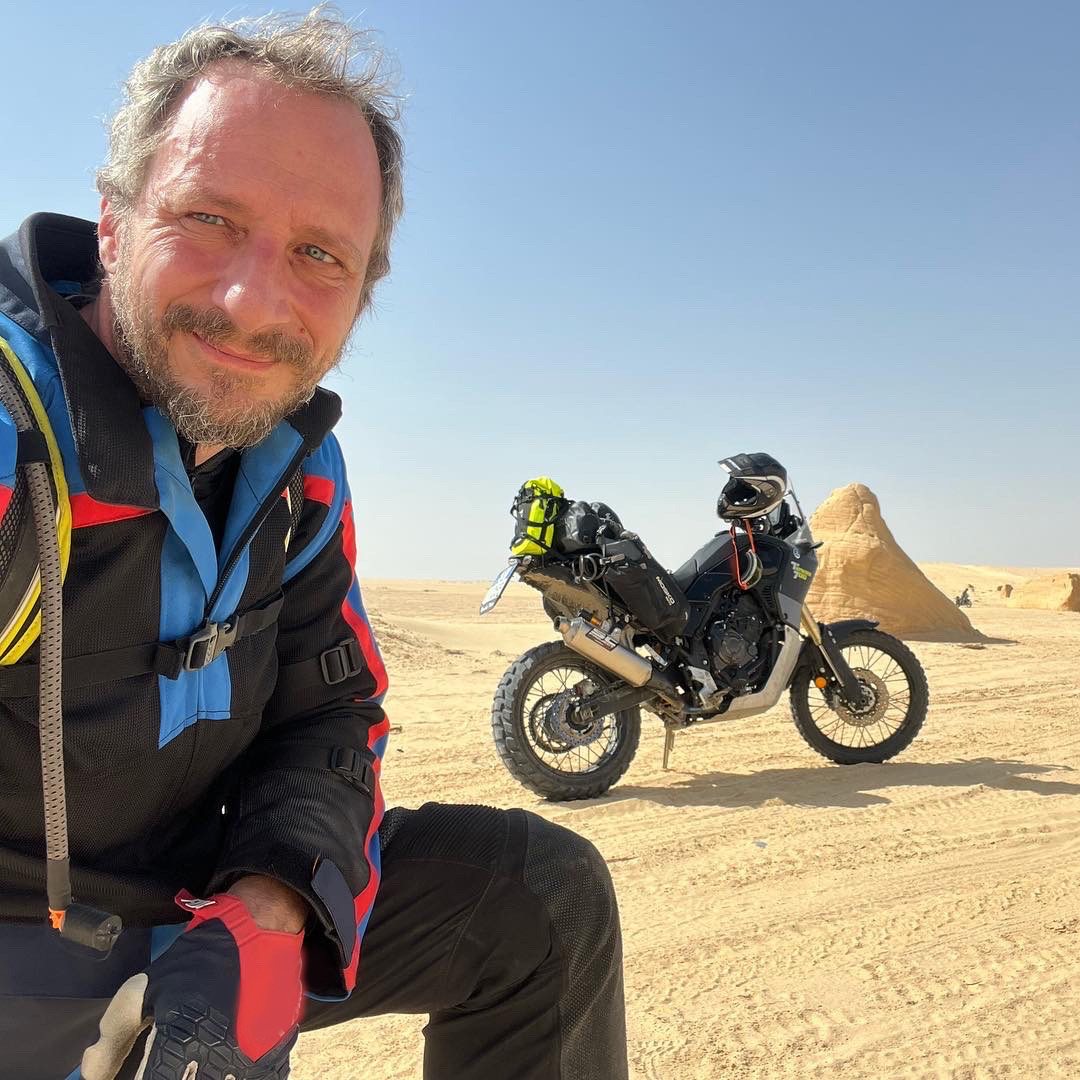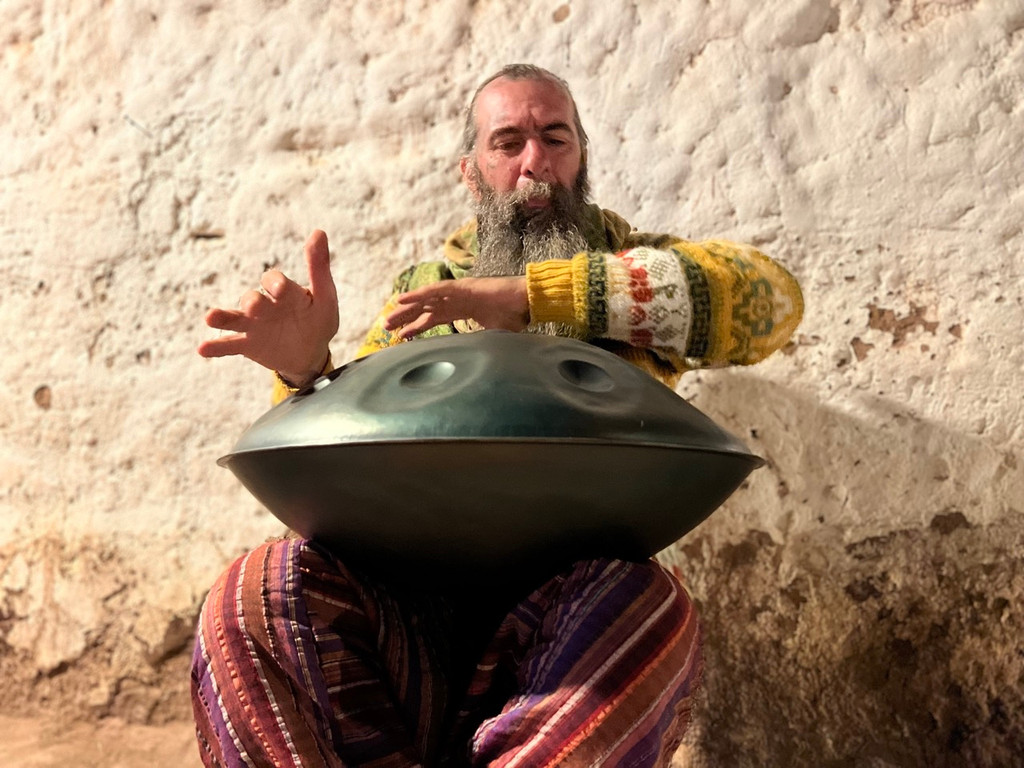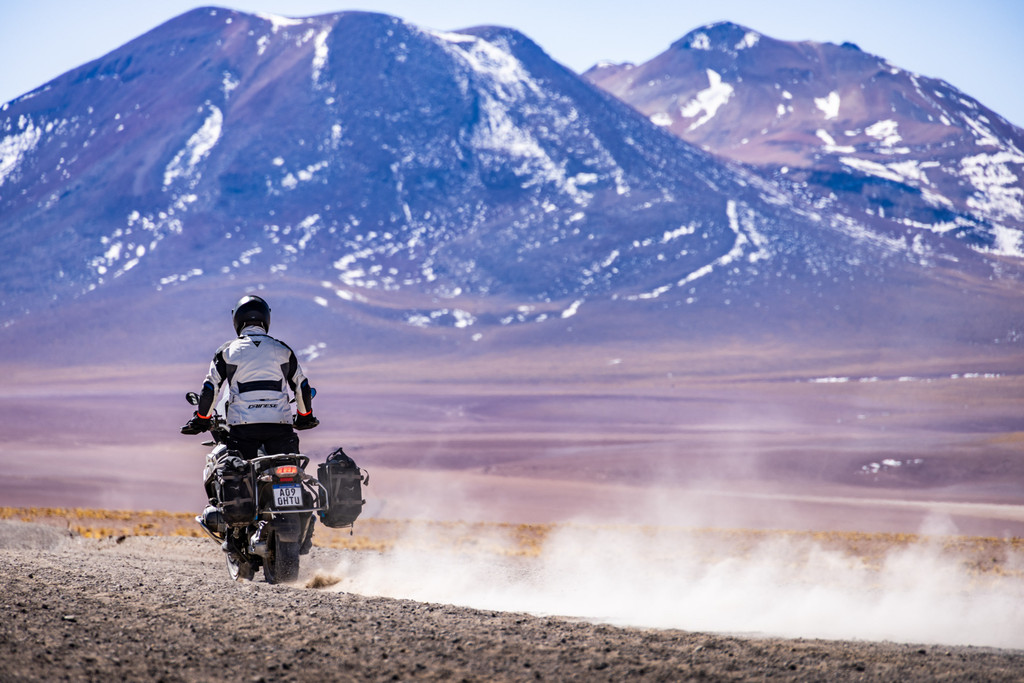
Tester for Motociclismo magazine since 2001. I’ve tried everything in my life, from MotoGP™ to speedway. The great thing is that I love everything on two wheels. I followed several editions of the Croatia Rally as a photographer and video maker and I rode in a couple of rallies, in addition to Pikes Peak in 2008, when there was still dirt as well as asphalt. When I have some time free from being a photographer and journalist, I take the enduro, single- or twin-cylinder, and ride through the woods, looking forward to being able to return among the dunes of the Sahara, my favorite place in the world.
The Andes have too strong a call to not go there at least once. Our trip, by motorcycle, is planned for the European summer, in order to find the South American winter, with temperatures from cool to cold, no scorching heat. In the end, if you dress properly it’s much better that way. You can deal with the cold by covering up. In hot weather it’s more difficult. We set off from Salta in northern Argentina, with a BMW R1200GS rented locally to ride. Watch out for the rental documents. It’s essential to have all the paperwork you need to get through customs. It takes nothing at all to get stalled at the border.
I can leave the waterproof bag with my stuff on the support vehicle behind us, so in the end I only have to put a few useful things for the day in the bike’s hard cases – heavy gloves, an extra sweatshirt, rain suit, and water bottle. In my case, I also have to fit some of the camera equipment. I’m a photographer and have lots of things to carry with me all the time, but anyone who has a passion for photography will have different materials with them. My advice is to never put camera body or lenses on the bike, whether it’s the side cases or the tank bag. When you’re off-road, the hits that the bike receives are much more significant than what reaches the rider, so it’s almost mandatory to put camera and lens in a backpack or pouch, while a small tripod can go in the case.
From Salta we head north remaining on Argentine soil to reach the famous Purmamarca, an incredible place where we arrive in the late afternoon. Red rock mountains, which blaze with the sunset, and even more with the first morning sun. It’s so strong that you want to lower the saturation when you look at the photos, because such a vibrant red seems fake, but it’s really like that! Here too is the mountain of seven colors, with its layers of different shades, among the first examples of the nature that awaits us over the coming days in increasingly majestic forms.
We pass the Paso de Jama with its 4,200-meter elevation to enter Chile, then continue a few dozen kilometers on the Andean plateau at 4,800 m, in a lunar landscape. It starts to get cold. We’re just below freezing and there’s also a strong wind, then the descent to San Pedro de Atacama at 3,159 m begins. This nosedive, on asphalt, brings the temperature above 15 °C in the space of a dozen kilometers and less than a quarter of an hour – ridiculous!

San Pedro de Atacama is a small Chilean town located on the Altiplano of the Andes, the one that left me with my best memory of the whole trip. It’s an important crossroads for many travelers, and I was very sorry not to have been able to spend at least one full day there. There are no major tourist attractions; it’s a small town with many dirt roads, low houses, built on the ground floor only, but with a fantastic mixture of people and cultures. Walking through the streets of San Pedro, among musicians and artists of various kinds, is a memory I will carry with me.
The same is true of the first stop the next day, the unmissable Valle de La Luna, a desert area that has been regulated and turned into a national park. The unique character of the rock formations, the great sand dunes… everything suggests that we’re really on the moon, and we appreciate their wanting to protect such a magical place. You can cross it, by car and motorcycle, if you pay the entrance fee, instructed to limit your speed to 40 km/h, dropping to 20 km/h for certain stretches. It’s very slow, but you certainly don’t come here to do drifting – you walk and enjoy the extraordinary spectacle that these absolutely unique mountains offer. It’s another place to keep in your heart.
The journey continues, with loads of asphalt. We pass through little villages, lagoons, two different salars (we already crossed one in Argentina) and the views you saw and dreamed of during the first South American Dakars – deep-blue lakes, llamas grazing the grass, a volcano in the background, the dirt road traced out in this earthly paradise. No two ways about it – it’s hard to ride in this region of the Andes without being moved.
Chile may by the fastest-developing country in South America, and you can tell even just by riding though it. One aspect that already lets you know it’s in good condition is its currency. The Chilean peso has a fixed, official exchange rate that’s very different from the one for the Argentine peso. The latter has an official exchange rate of approximately 1:170 against the American dollar. That is, for every USD you get 170 pesos, but that’s the value the government indicates, the one you’ll get at the official currency exchange, not the real-life value. There’s horrific inflation, which the government refuses to officially acknowledge but which has effectively brought the value of the peso way down (it takes over 300 to get 1 USD), and you notice every time you pay for something in cash instead of using a card. There’s a two-and-a-half times difference! In Chile that doesn’t happen, and you should know that if you have leftover Argentine pesos you can take them home and put them up on the wall, because no one will ever change them for you, either to make purchases on the Chilean border or still less the at the currency exchanges.
Our journey continues along Ruta 21 toward Calama; we’re in the Antofagasta region, a continuous succession of deserts and volcanoes, until we reach the border with Bolivia, where we arrive around lunchtime. We remind ourselves that patience is a virtue and begin the customs paperwork. You go to the first office, then they send you to the second, 100 meters ahead. Then you go back to make a photocopy, then you go to a third office and they tell you there’s a sheet missing. It’s okay without it though; you go ahead to the fourth office, sign again and come back. You put your right leg in. You put your right leg out. You put your right leg in. And you shake it all about. Then you close your eyes, take a deep breath, seeing as we’re over 3,500 m, and stay calm, because South American borders are often like this. Actually, the procedures from Argentina to Chile were quick, whereas here and to return to Argentina from Bolivia it’s a different story. They’re very strict when it comes to checking documents to enter Bolivia, and today’s stage, of more than 500 km, is a bad match for these delays.
Once we cross the border we know we have less than two hours of daylight and there’s nothing, absolutely nothing, until Uyuni. It’s 230 km, a ride of nearly 4 hours, on ruined roads and off-road, half of which in the dark, with temperatures reaching −10/−15 °C… The smart choice was to prepare all the documentation but not cross the border that day, sleep at the border village of Ollague and set out early the next morning. Never was a decision more on the money.
We’re at an altitude of 3,700 m, looking for a shelter for the night and find a little place run by a super-friendly little family who are happy to have us as guests. We get into the rooms and notice that the heating comes and goes. Big blankets for tonight – that’s just the way it is. Before dark, we take the bikes to the back of the guesthouse, to a small courtyard between two walls, to keep them slightly sheltered from the air – here the temperature drops a lot at night and we would have found them frozen the next morning.
The amazing starry sky, the railroad with the old freight train, the active volcano of Ollague a handful of miles away, the historic Cappella di Sant’Antonio with its two white crosses standing out against a dark sky full of stars. The urge to admire this place on a night like this and take a few photographs was stronger than the biting cold of the −13 °C getting into my bones…
We get an early start in the morning, and the road from Ollague to Uyuni is as beautiful as it is treacherous, which makes us realize how wise it was not to take it tired and in the dark. We arrive in Uyuni and then at the Salar, a magical place we’ve been dreaming about ever since the Dakar first passed there 10 years ago. We make an initial sally into the Salar with the afternoon sun and sunset, then return the next morning to go 90 km in. And the first feeling is one of wonder. Salt runs under the wheels and you think of things that only this place, up to now, has shown us so clearly: infinity, horizon, vastness. It’s a place that makes you feel like a grain of sand on Earth, taking a human being back to their nature as animals passing over the planet. You feel small, but also full with so much beauty. I’ll never forget this feeling, one of sheer beauty, but also one of being lost. It’s worthwhile to detach from the group, remain alone with ourselves, to admire the white and think that we’re where we want to be. And while I look at all this nothing, I get emotional and think of my dad, who left us a few weeks ago. I’d like to know that he’s in a place just as beautiful and able to give peace.
Here our frenetic rhythms slow, swallowed up in white, in nothingness, by a place that has always been the same. You arrive at the Incahuasi cactus island, talk to Alfredo and his wife (Alfredo is the only person ever to be born on the island), and find out that they live there, in a place far from the world, in the white sea of salt. They make us some outstanding coffees, and are happy to take some photos – they smile. They live on little and basically want for nothing. But by the time you think of it, you’ve already launched yourself flat out onto the salt in sixth gear, because there are things to do, places to go. And when it comes down to it, it’s OK that way. But I carry all that beauty inside me and I’m not about to let go.
